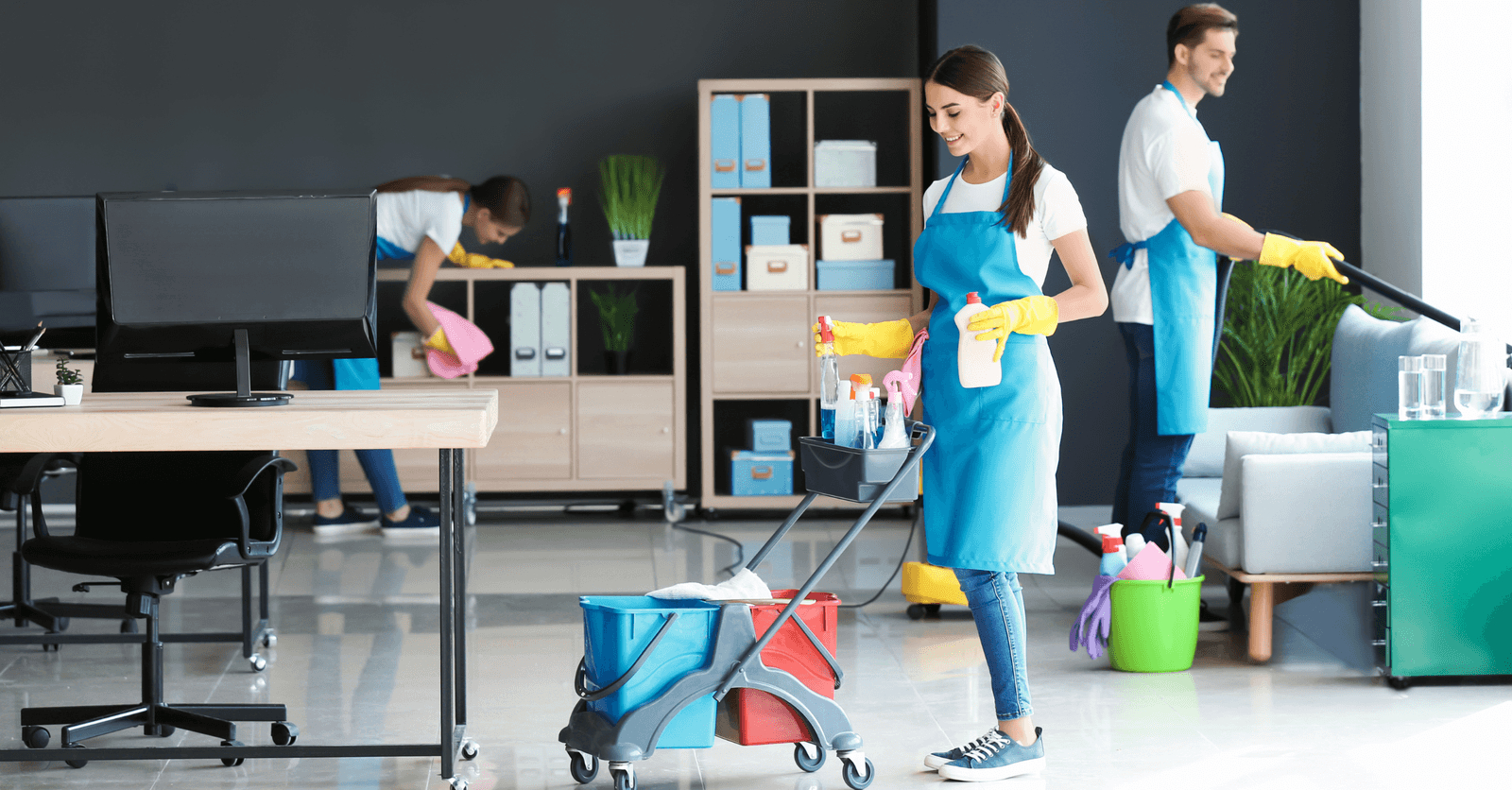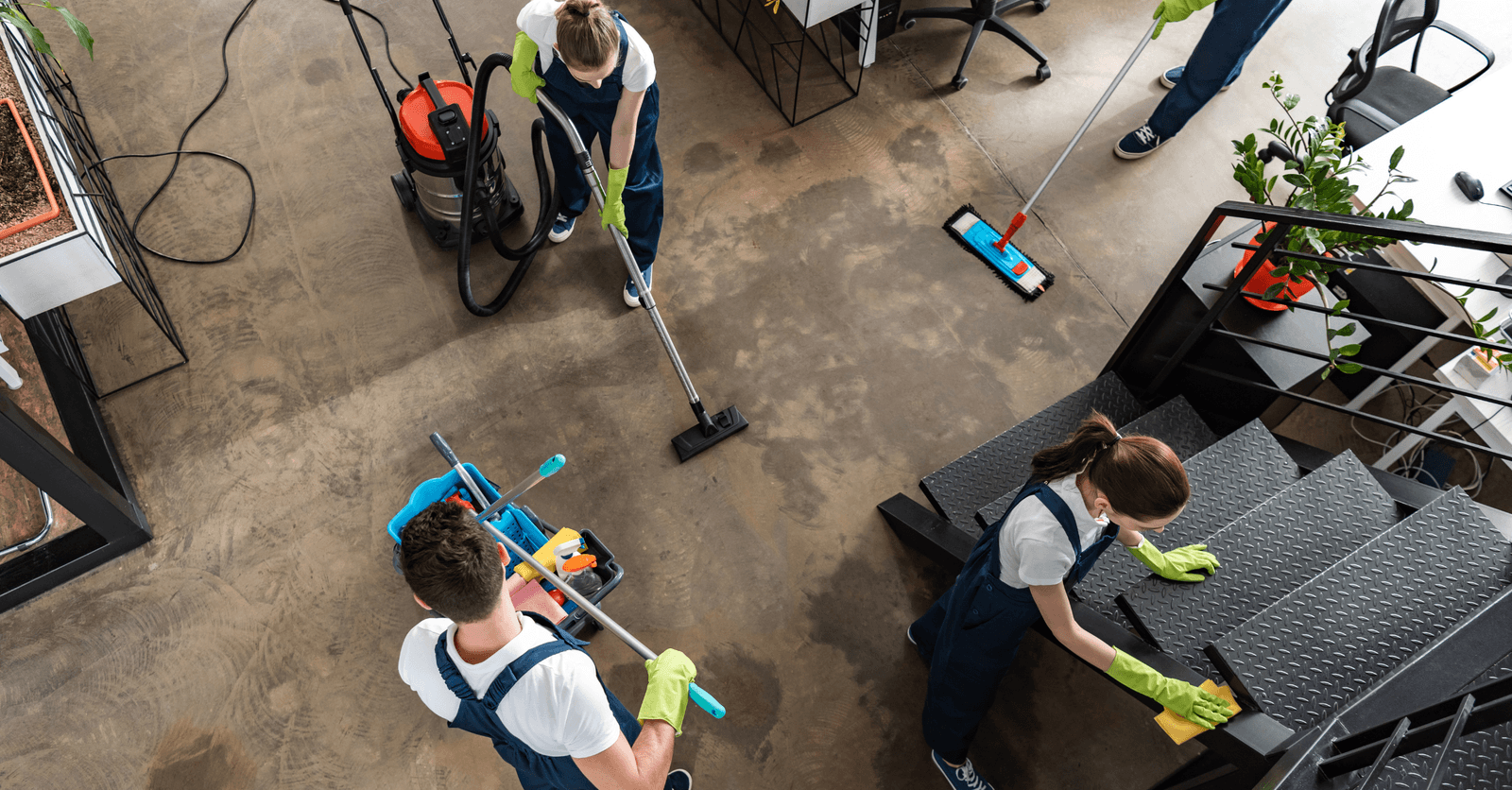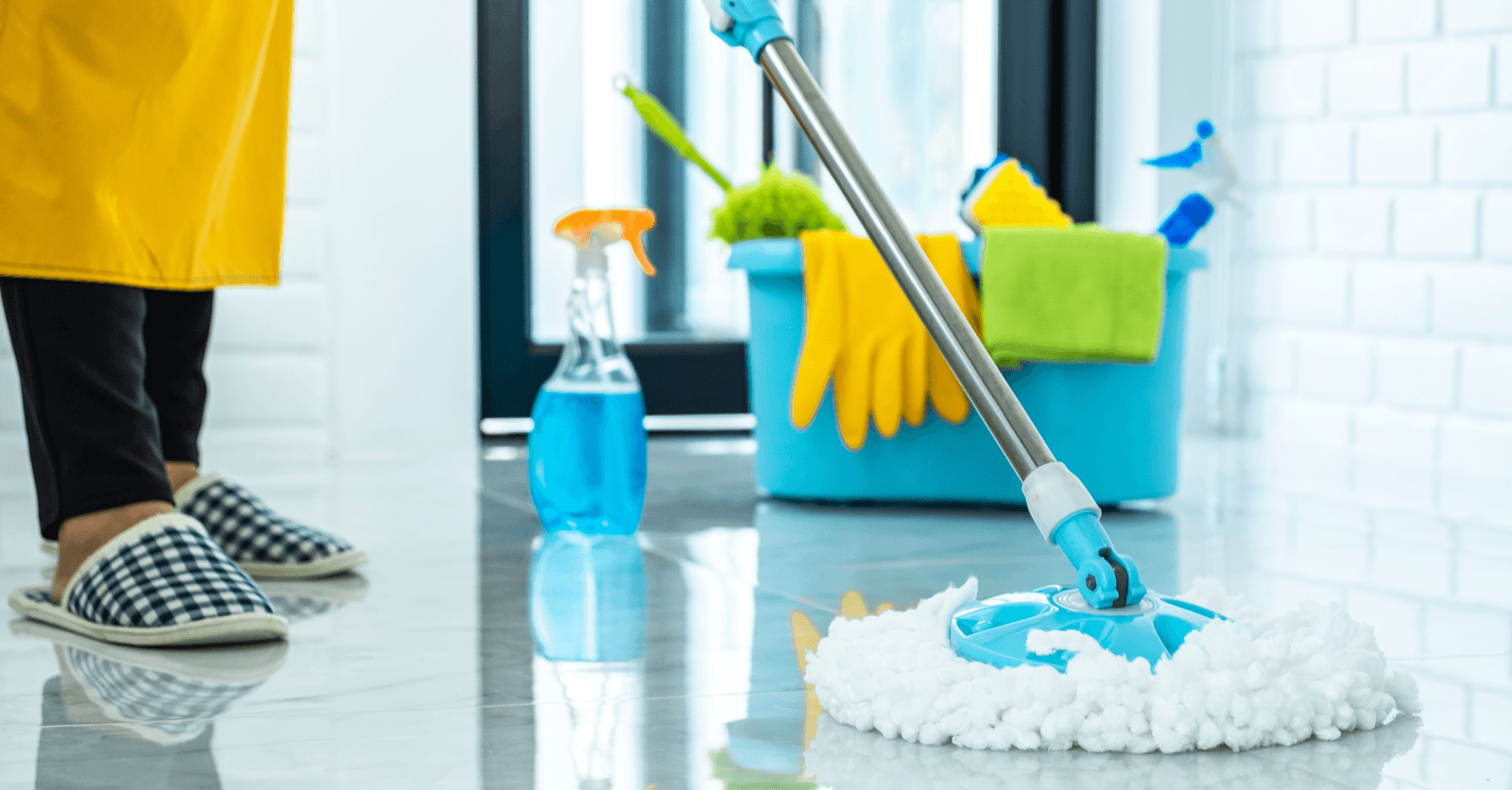To Know Before Signing a Commercial Cleaning Services Contract
By Editorial Team
Updated on April 12, 2024

When it comes to commercial cleaning services, a thorough cleaning from time to time doesn’t guarantee clean and healthy spaces for employees and occupants.
It’s quite the opposite actually, commercial buildings need housekeeping attendants to ensure clean, pleasant surroundings and preserve everyone’s health. Ricardo Ramirez, founder of Entretien Ménager SR, explains why and how to achieve it.
What is commercial cleaning?

Source: Canva
Ramirez defines commercial housekeeping as “all cleaning tasks and services done in commercial environments, such as offices or businesses.” (Translation)
Naturally, the total scope of activities includes several areas, which we will detail. Housekeeping services are, first and foremost, customized amenities based on the customer’s needs. However, there are key components to it.
What are the key components?
Waste Management
A business, no matter its field of operation, will accumulate waste throughout the course of its daily activities:
Paper
Plastic waste
Leftover food
And more
All lined up, it represents more than 35 million tons of waste generated by Canada every year. One of the purposes of a cleaning services company is to reroute such waste to allow for recycling or disposal.
Floor Cleaning
Cleaning commercial flooring requires professional equipment:
Walk-behind floor scrubber
Vacuum and steam system
Steam cleaner
Mechanical sweeper
And others
Commercial cleaning differs from standard housekeeping because it focuses on a transitory setting. The risks of transmitting diseases or infections are much greater.
Indeed, while certain buildings are more concerned than others, such as medical clinics or hospitals, all business floors are more or less contaminated with viruses, bacteria, and fungi. Instilling such a responsibility to a professional is a public health must-have. In fact, let’s segue into another service: disinfection.
Disinfection
Something as simple as cleaning surfaces with a disinfectant, and doing so on a regular basis, mitigates the following:
The spread of diseases
Workplace absenteeism
Drop in productivity
A study done by researchers from the University of Arizona brought to light that each flu season leads to the following:
Between 1 and 4 sick days
30% drop in productivity
$127 billion in overall economic costs (USA alone)
What was made evident by said researchers is that professional cleaning services mitigate the concentration of harmful pathogens by 41.7%.
However, said maintenance can’t be done with whichever product one can lay their hands on. All disinfectants used by commercial cleaning services companies are labelled with a DIN (Drug Identification Number), which is a Health Canada-assigned eight-digit number green-lighting its use in the country.
Window Cleaning
Windows are representative of two things for retail stores and businesses:
an opening onto the outside world for employees; and
storefronts for customers.
The least that can be said about dirty windows is that they can tarnish the reputation a business has acquired, and demoralize its employees.
Yet, cleaning commercial windows is a challenging feat. Based on the sheer height of the windows, the amount of windows, and how easily accessible they are, only professionals can take action.
Sanitary Maintenance
This area requires serious housekeeping skills. The goal behind sanitary maintenance is to limit the spreading of infectious diseases. Note that flushing a toilet releases bacteria and viruses.
To limit the risk of contaminating the floors and walls of public restrooms, automatic toilet bowl cleaners can be placed inside toilet tanks. Also, thorough cleaning of the bottom of the toilet will eliminate any traces of salmonella.
Otherwise, such bacteria, if thorough cleaning is neglected, will live for no less than 50 days on the colonized surface.
Another issue with non-professional cleaning is the spreading of toilet germs to sinks. To avoid propagation, public toilets must be cleaned with soaps and cleaners containing disinfectants. Why? Because a disinfectant won’t eliminate germs, but rather neutralize them. As such, any sort of bacteria spreading from the toilets to the sinks is rendered harmless by the products used.
Kitchen and Lounge Area Cleaning
Kitchens are oftentimes petri dishes for resistant bacteria. The latter can contaminate fabrics, rags, etc. Professionally cleaned and wiped surfaces will eliminate all traces. As such, a professional cleaning crew will always use, for kitchens at least, a detergent-base cleaning product.
That same goes for break rooms or lounge areas, both of which are spaces where staff is likely to snack or where one might bite their nails and proceed to spit out the clippings on the floor. Break rooms must be cleaned upon staff arrival, and cleaned once a day to guarantee sanitary surroundings.
Green Space Management
Certain businesses like Entretien Ménager SR also offer green space management services. This sort of landscaping work is the last link in the value chain that a commercial cleaning service company might offer.
From corporate office restrooms to commercial spaces, with landscaping in the middle, the entire scope of elements that shape the business’ brand are taken into account. This process is exactly what homeowners who list their homes on Airbnb deal with.
Supply and Provision Management
To undertake such maintenance services under the best possible conditions, housekeeping professionals ensure that the must-have products to carry out tasks are present on-site.
Properly managing supplies, courtesy of an inventory and regular provisioning, ensures quality services.
How to Carry Out a Professional Cleaning

Source: Canva
The 9-Step Guide to Provide a Good Service
1. Plan and organize work
To carry out a decent cleaning, proper organization is mandatory. Being organized doesn’t solely mean swiftness, but it also assures proper work methods.
The right method is one that does not spread bacteria from one area to another, or result in airborne contaminants on account of a poor intervention method.
2. Gather supplies and equipment
Each area to clean is unique. Restrooms don’t require the same equipment or the same products as those used to clean an office space.
As such, one must gather the right products and equipment to carry out individual tasks.
3. Clear and organize
A surface can only be properly cleaned if it’s cleared of all things. As such, all surfaces must be cleared and then reorganized once cleaned.
There are limits to how much can be cleared from a surface, and that mostly concerns individual office desks. In fact, the latter can’t be cleared or reorganized, as every employee is productive on account of a unique system.
4. Dust surfaces
The majority of the dust must be wiped from surfaces prior to cleaning with more significant products and equipment. Dusting prevents specialized equipment bags and filters from filling up too quickly.
5. Damp cleaning
Why proceed with a damp cleaning? Because it traps dust, therefore, bacteria and viruses. With steam-operated equipment, spores and other contaminants remain on surfaces rather than becoming airborne.
6. Windows and mirrors
Windows and mirrors are the number one eye-catching features in a room. They have a lot to do with the aesthetic of a room. As such, they must be perfectly cleaned after a professional cleaning service has been through.
7. Floors, restrooms, kitchen, common areas
Floors, restrooms, kitchens, and common areas are the most important areas to clean. As we already mentioned, they’re underlined areas, given the following:
Germs
Viruses
Bacteria
Commercial cleaning services pay special attention to pathogens, given high-traffic areas that need to be properly disinfected.
8. Final check
Housekeeping attendants may forget certain details during their maintenance routine, and that’s why a final check is of utmost importance prior to moving on to the next room.
Doing so allows you to ensure:
everything is clean; and
nothing was forgotten.
9. Regular maintenance
Professionals must present a maintenance plan. The latter is supposed to meet your needs as a customer, based on the areas the clean and the number of people that frequent the areas in question.
Essential Cleaning Products and Equipment
Ricardo Ramirez, the CEO of Entretien Ménager SR, highlights that among the products most commonly used are the following:
All-purpose cleaner
Disinfectants
Window and floor cleaners
Degreasers
Descaling agents
Task-specific products
Eco-friendly products
The most commonly used pieces of equipment are as follows:
Vacuums (steam, dry, backpack, upright)
Brooms and mops
Microfibre rags
Press down mop wringers
Protective gloves
Scrub brushes and sponges
Scrubbing sponges
Tank sprayers and vaporizers
Protective gear (mask, protective goggles, cleaning uniform, etc.)
Window cleaners
Bin and trash bags (garbage bags, sterilization pouches, feminine product disposal bags, etc.)
Safety and Ecological Standards Regarding Commercial Maintenance
In the field of commercial cleaning services, the standards by which housekeeping attendants must abide are, first and foremost, ecological standards related to the chemical products used. In Canada, the DIN label ensures the cleaning product in question is authorized.
Said number issued by Health Canada applies to the following:
Disinfectants
Disinfectant wipes
Antibacterial hand soap
Sanitizers
The DIN label guarantees the product’s composition doesn’t present any health risks for users.
To that, one must add the right measures by which industry-related commercial cleaning businesses must operate. As such, the CEO of Entretien Ménager SR, Ricardo Ramirez, also steered his entrepreneurial approach toward an eco-friendly one due to the following:
the use of eco-friendly products;
proper waste management;
water and energy conservation; and
raising awareness among his team about sustainable purchases and reducing their carbon footprint.
Proper Staff Training for Quality Services
Commercial cleaning services are particular since housekeeping attendants intervene in all sorts of areas, with numerous different products, in oftentimes harsh working conditions. Staff are exposed to specific risks, which mandate them to familiarize themselves with the following:
Risks of spreading infections
Chemical risks
Musculoskeletal disorders (MSDs)
Personal protective equipment
Managing these risks requires employers to have their staff complete specific training programs. Housekeeping attendants must know how to manipulate chemical products on-premises and do so within the bounds of proper measures:
Setting up ventilation
Wet floor signs
Risk management
As such, all commercial housekeeping-trained attendants will complete the following training programs:
Commercial cleaning professional training
Occupational and public health and safety training
Chemical product safety training
Cleaning equipment training classes
Cleaning methods training programs
Customer service skills training
Waste and environmental management classes
Team management training
How to Put Together a Quote for a Commercial Cleaning Contract

Source: Canva
Assess the Maintenance Needs of a Business
When putting together a commercial cleaning contract, industry professionals will include the following criteria:
The size of the space to clean
The complexity of the space (protected area, accessibility, etc.)
Maintenance frequency and schedule (nighttime work, etc.)
Level of service and specific tasks
Equipment and products required
Location of premises (commuting distance)
Number of housekeeping attendants needed on-site
Duration of contract
Current market (competition)
Customer requirements or special requests
Factors Affecting Pricing
Among the previously cited factors, the surface to clean (time needed to clean), the number of housekeeping staff, as well as the equipment to use, and the timetable to abide by are just some of the criteria that will largely influence service costs.
Since all customers are unique and have their own specific needs and requirements in terms of housekeeping, the charged rate is also highly variable.
Types of Rates
One can account for no less than 10 different types of rates. Here’s why it’s important to reach out to several cleaning service companies for free quotes.
Rates | Characteristics |
Hourly rate | It’s rather straightforward; every hour worked is compensated according to the previously negotiated rate as stipulated by the contract. |
Square footage rate | The bigger the space to clean is, the more the housekeeping costs will be high. Therefore, it may be that the rate charged isn’t all that optimal. |
Fixed service rate | Such pricing means negotiating the services to be done based on a fixed service rate, payable all at once, or in installments based on the terms of the contract. Said pricing is fixed and the cleaning company cannot wager from it, whether they come in at a loss or not. |
Frequency-based cleaning rates | Daily, weekly, or monthly services are negotiated between the customer and the maintenance company. |
Per-request rate | Per-request pricing is what’s also known as pay-per-task billing. This type of invoicing is ideal for companies that have fluctuating activities and on-site personnel. When needed, commercial housekeeping companies are sought and services paid. In other words, if no services are done, no money is exchanged. |
Cost-per-headcount | When a significant amount of work is needed, several housekeeping attendants can be called upon to clean a company’s workspace. In such a case, the rate might be dependent on the number of attendants present on-site. |
Mixed rates | It’s a combination of several of the above-mentioned rates. Mixed rates invoicing may be required in certain specific situations. |
Progressive pricing | The customer is unsure about committing to a cleaning services company. The company can then suggest progressive pricing. In the beginning, they will charge little, and as time goes by, the rates will increase based on cleaning needs, until rates reach market value. |
Seasonal rates | This type of pricing is much closer to the current state of the market. As a customer, you’re paying based on demand. If the cleaning company isn’t overwhelmed with work, you pay less, and on the flip side, you pay more. |
Commercial Cleaning Services: The Key to Cleanliness and Success
A commercial housekeeping contract plays a key role in the cleanliness, presentation, and proper functioning of a business. It ensures the workspace is clean and healthy, thereby fostering the well-being of its employees and the customers' positive outlook. As a business owner, you need to customize your contract based on specific needs, covering services like regular maintenance, floor cleaning, waste management, and much more. By investing in quality maintenance, you will foster an inviting, functional, and professional workspace. As such, your maintenance contract should be seen as a strategic asset for your company.
Get 3 quotes for commercial cleaning services
RenoQuotes.com can help you get quotes from a general contractor. By submitting your project, we’ll put you in contact with top-rated contractors. Fill in the form on the homepage (it only takes a few minutes) and get estimates from trusted professionals.
Dial 1-844 828-1588 to speak with one of our customer service representatives.
Looking for something else?